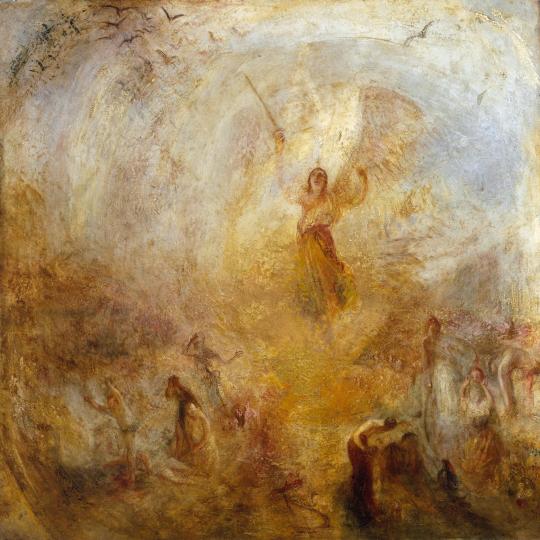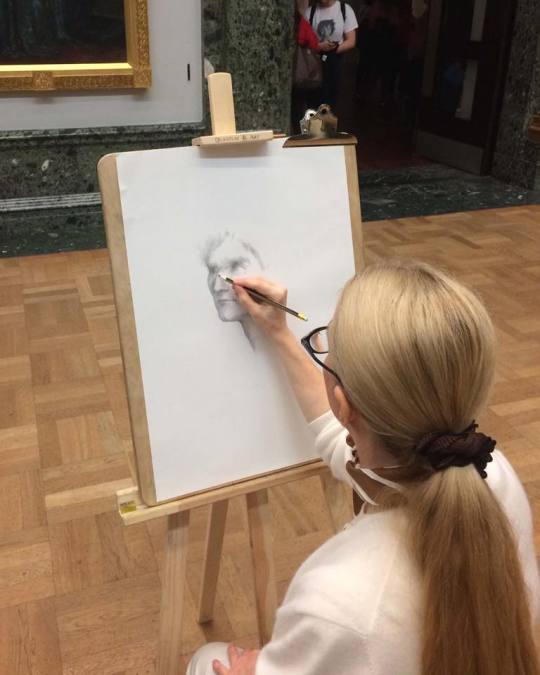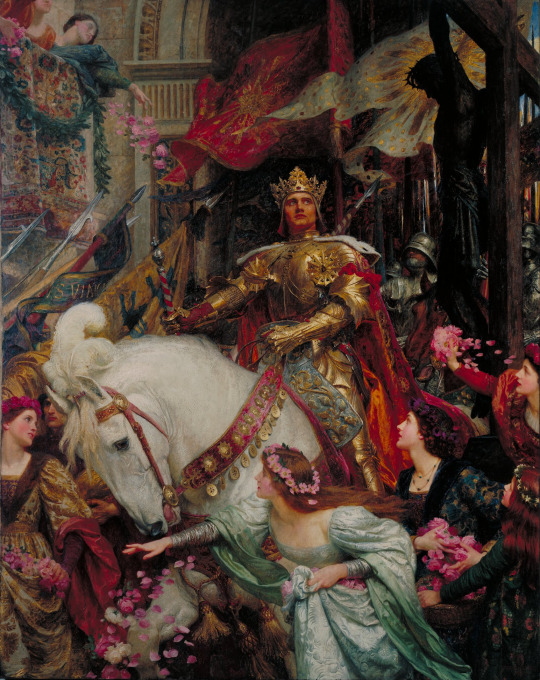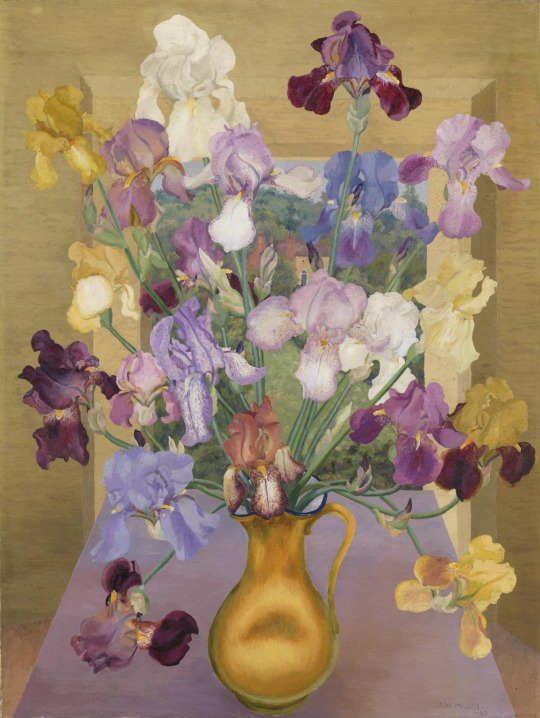#tate britain
Explore tagged Tumblr posts
Text

The Flower Girl
Artist: Sir James Jebusa Shannon (Anglo-American, 1862–1923)
Date: 1900
Medium: Oil paint on canvas
Collection: Tate Britain, London, United Kingdom
Description
James Jebusa Shannon painted this work while he and his family were on holiday in Eastbourne. The woman was a flower girl who they met every morning on their way down to the beach. She agreed to sit for Shannon in her ordinary working clothes while nursing her baby. The artist’s daughter, Kitty, recalled that her father told the flower girl to come ‘exactly as you are: baby, basket of flowers, the white blouse with the big black spots and old battered straw hat’.
#painting#genre art#oil on canvas#eastbourne#woman#flower girl#baby#basket#flowers#foliage#english culture#english art#oil painting#artwork#fine art#sir james jebusa shannon#early 20th century painting#european art#tate britain
40 notes
·
View notes
Text

The Angel, Standing in the Sun, J.M.W. Turner, 1846
#art#art history#JMW Turner#J.M.W. Turner#Joseph Mallord William Turner#religious art#Christian art#angel#angels#sunlight#Romanticism#Romantic art#English Romanticism#British art#English art#19th century art#oil on canvas#Tate Britain
3K notes
·
View notes
Text

This photo of me drawing at the Tate Britain Museum in London was taken by my assistant and comic art restoration specialist Allan Harvey back in 2017 - when I still had hair.
I like to do studies of art while in museums, but sometimes I like to wig people out by drawing from my imagination, as I am doing here.
It was fun seeing people trying to figure out what I was copying when I wasn't actually copying anything.
Petty artist thrills. Good times.
I was sitting in front of William Holman Hunt's painting The Lady of Shallot.
4K notes
·
View notes
Text

Thomas Benjamin Kennington (1856-1916) "Orphans" (1885) Oil on canvas Social realism
#paintings#art#artwork#genre painting#genre scene#thomas benjamin kennington#oil on canvas#fine art#social realism#tate britain#english artist#british artist#portrait#portrait of a child#children#clothing#clothes#orphan#sad#tragic#sorrow#1880s#late 1800s#late 19th century\#a queue work of art
166 notes
·
View notes
Text

Christopher Richard Wynne Nevinson (British/English, 1889-1946) • A Studio in Montparnasse • exhibited 1926 • Tate, Britain
#art#fine art#painting#art history#christopher richard wynne nevison#british/English artist#british modernism#20th century british art#oil painting#tate britain#paintings of interiors#paris#paintings of domestic interiors#art nude#interior with figure#the painted room art blog#art blogs on tumblr#art lovers on tumblr
410 notes
·
View notes
Text

Augustus John (British/Welsh, 1878-1961) • Blue Cineraria • c. 1928. • Tate Britain
#still life#art#painting#fine art#art history#augustus john#british/welsh artist#floral still life#post impressionist#artwork#artist#oil painting#collection still life blog#art blogs on tumblr#art lovers on tumblr#tate britain
103 notes
·
View notes
Text

Sculpture on Front Terrace, Tate Britain, London, 1 20 25, Photo by Joe Bruha, Copyright 2025
47 notes
·
View notes
Text

Life's Illusions
Artist: George Frederic Watts (British, 1817–1904
Date: 1840
Medium: Oil on canvas
Collection: TATE Britain
Description
Life's Illusions is an allegorical painting that explores the vanity of human desires. Watts believed that art should reveal the mystery of being, and he used universal symbols to represent life's emotions and aspirations.
#painting#allegorical art#life's illusions#oil on canvas#vanity of human desires#british art#symbolist movement#symbolism#oil painting#symbols#emotions#aspirations#male figures#female figures#george frederick watts#british painter#british culture#19th century art#artwork#european art#tate britain#19th century painting#pre raphaelite
44 notes
·
View notes
Text

The Minotaur
Artist: George Frederic Watts (British, 1817–1904)
Date: 1885
Medium: Oil paint on canvas
Collection: TATE Britain, United Kingdom
Description
In Greek mythology the Minotaur, half-man, half-bull, was appeased by annual human sacrifices. Every year, seven youths and seven virgins were shipped from mainland Athens to the Island of Crete to be devoured by the monster. In Watts's painting, the Minotaur leans out across the sea from a high parapet in anticipation of the ship's arrival. The yellow sunlight of the breaking dawn glints off the shoulder of the beast, accentuating his powerful body and catching the hairs of the tail that flicks out behind him. On the parapet, the Minotaur's large, hoof-like fist has crushed a small bird, a recognised symbol of the innocence and purity of youth.
#painting#mythological art#greek mythology#the minotaur#british culture#oil on canvas#artwork#half man-half bull#monster#sea#horizon#british painter#george frederic watts#british art#oil painting#fine art#tate britain#british symbolist painter#19th century painting#european art
36 notes
·
View notes
Text

The Good Samaritan
Artist: Joseph Highmore (English, 1692–1780)
Date: 1744
Medium: Oil paint on canvas
Collection: TATE Britain
Description
This painting illustrates the parable of the Good Samaritan from the Gospel of Luke. The Samaritan has bound the wounds of an injured man attacked by robbers and is helping him to his feet. Heading off into the distance behind them are the priest and the Levite, who have ignored the man’s plight. The painting was made for the aristocrat John Sheppard, possibly for a private chapel in his home at Campsey Ashe in Suffolk. This makes it a comparatively rare example of a sacred subject commissioned from a British artist by an independent patron, outside of the church.
#the good samaritan#jesus' parable#christianity#landscape#men#priet#levite#gospel of luke#narrative art#christian art#oil on canvas#oil painting#18th century painting#tate britain#joseph highmore#english painter#wounded man#english art#artwork#european art#bible story
43 notes
·
View notes
Text





JMW Turner:
Snow Storm - Steam-Boat off a Harbour’s Mouth, exhibited 1842
Whalers (Boiling Blubber) Entangled in Flaw Ice, Endeavouring to Extricate Themselves, exhibited 1845
Rough Sea, c.1840–5
A Wreck, with Fishing Boats, c.1840–5
Seascape with Storm Coming On, c.1840
All paintings displayed in Tate Britain, Room 35, "Toil and Terror at Sea".
57 notes
·
View notes
Text

The Two Crowns, Frank Dicksee, 1900
#art#art history#Frank Dicksee#Sir Frank Dicksee#historical painting#Middle Ages#medieval#religious art#Christian art#Christianity#British art#English art#19th century art#Victorian period#Victorian art#oil on canvas#Tate Britain
3K notes
·
View notes
Text

Lady Jane Grey Prevailed on to Accept the Crown
Artist: Charles Robert Leslie (English, 1794–1859)
Date: Exhibited 1827
Medium: Oil paint on canvas
Collection: TATE, Britain
The Shortest Reign in British History
Lady Jane Grey was Queen of England for just nine days, from 10 July to 19 July 1553. She was proclaimed Queen as part of an unsuccessful bid to prevent the accession of her Catholic cousin, Mary Tudor. The great-granddaughter of Henry VII, Jane inherited the crown from her cousin Edward VI.
Jane arrived at the Tower of London to prepare for her coronation, but within a fortnight she was back as a prisoner of Mary I who had claimed the throne as rightfully hers. While Mary was reluctant to punish her at first, Lady Jane proved too much of a threat as the focus of Protestant plotters intent on replacing Mary.
On 12 February 1554, Lady Jane Grey was executed on Tower Green at the Tower of London. She was 17 years old.
#painting#lady jane grey#interior scene#men#costume#table#document#british history#oil on canvas#fine art#artwork#oil painting#british monarchy#charles robert leslie#english painter#european art#tate britain#19th century painting
24 notes
·
View notes
Text

Satan, Sin and Death (A Scene from Milton’s ‘Paradise Lost’)
Artist: William Hogarth (English, 1697–1764)
Date: c. 1735-1740
Medium: Oil paint on canvas
Collection: TATE Britain, United Kingdom
Paradise Lost Epic Poem
Paradise Lost is an epic poem in blank verse by the English poet John Milton (1608–1674). The first version, published in 1667, consists of ten books with over ten thousand lines of verse. A second edition followed in 1674, arranged into twelve books (in the manner of Virgil's Aeneid) with minor revisions throughout. It is considered to be Milton's masterpiece, and it helped solidify his reputation as one of the greatest English poets of all time. The poem concerns the biblical story of the fall of man: the temptation of Adam and Eve by the fallen angel Satan and their expulsion from the Garden of Eden.
The main conflict of the poem involves Satan’s jealous desire to corrupt God’s new and beloved creation by creating human distrust in God’s plan, a distrust that will lead to disobedience. Through the temptations of the antagonist, Satan, Milton emphasizes the corruption to which humans are vulnerable if they are not spiritually aware of the manipulative power of evil around them. Adam and Eve’s inner struggle, an effort to resist temptation, symbolizes the innate human desire to stay loyal or true to a spiritual compass, which, in Milton’s poem, is represented by God’s exhortations and the messages of his angels.
The inciting incident of the poem finds the antagonist, Satan, banished to hell, where he and his fellow devils construct a temple called Pandemonium, a symbol of chaos and irrationality, and then plot both to make a good out of evil and an evil out of good. Milton portrays the devils’ apparently democratic decision as ironic evidence of their failed capacity for reason: Satan refuses to accept God’s rational hierarchy—that the Son is superior to him—and settles on irrational disobedience. In an allegory reminding the poem’s readers of a conventional Christian understanding of the fall, Satan begets Sin who begets Death. He volunteers to corrupt God’s new and beloved human beings, and a bridge is built between Hell and Earth.
The rising action explores ideas about free will and a redemption in which God’s Son will willingly sacrifice himself, God’s plan for human salvation. The Son is the instrument through which God acts, and Milton shows how God and the Son work separately, yet are manifestations of the same entity, working as one. Free will is one of the major themes of the poem, and Milton suggests a paradoxical idea about it: a human being is free to choose, yet is only truly free when choosing the good. Events unfold as Adam is visited by the Archangel Raphael who recounts the story of creation, reveals the primary conflict between God and Satan, and describes the latter’s fall and the War in Heaven. The war stands as an extended spiritual metaphor in which disobedience leads to one’s blindness from the truth. Raphael warns Adam to be wary of Satan’s temptations; Adam’s choice will rest entirely in his own hands.
At the poem’s climax, Satan accomplishes his goal by convincing Adam and Eve to become disobedient. Plagued by envy and despair, Satan flatters Eve, convincing her to eat the forbidden fruit from the Tree of Knowledge. He presents knowledge as a means with which she might equate herself with God, using his perverted reasoning to demonstrate how knowledge can be used for evil. Eve, in turn, convinces Adam to join her in this act of disobedience, and he dooms himself, unable to bear the thought of losing her. Ultimately, he chooses loyalty to Eve over loyalty to God. As the pair’s heightened senses take over, their capacity for reason diminishes. The further Adam and Eve drift from God, the more reduced their powers of reasoning become.
In the falling action, Adam and Eve awaken to their banishment from Paradise. They find themselves in a world of shame and evil, blaming each other for their condition, and Sin and Death subsequently enter the world. The fall, however, paves the way for humanity’s redemption and salvation; thus, Milton claims that his epic surpasses the ancient classics, as it pertains to all of humankind, not to a single hero or nation. The archangel Michael grants Adam visions of a future in which his offspring commit murder, as well as scenes of people living for pleasure and the flesh. Unlike Satan, Adam and Eve repent by praying to God.
Michael, in the poem’s resolution, recounts the idea that a Messiah will eventually arrive to reunite Heaven and Earth, noting that there will be much suffering before that reconciliation. Milton suggests that Adam and Eve’s fall is the “felix culpa,” or happy fault or fortunate fall, for God’s mercy is shown. Individuals, he suggests, may hope to redeem themselves through devotion and obedience to God, forming an aspect of his ultimate plan. Comforted by these suggestions, Adam and Eve, in the poem’s final scene, exit into a new world. They have been led to understand that obedience to God and his love for his creation will lead humanity toward salvation, toward regaining a Paradise that has been lost.
#painting#poetry#epic poetry#paradise lost#milton's paradise lost scene#english poetry#john milton#literature#fallen angel#adam and eve#satan#sin and death#corruption#good versus evil#oil on canvas#fine art#oil painting#artwork#english culture#english art#william hogarth#english painter#18th century painting#tate britain
20 notes
·
View notes
Text

Cedric Lockwood Morris (British,1889–1982) • Iris Seedlings • 1943• Tate Britain
#art#painting#still life#fine art#art history#cedric morris#flower still life#british artist#british painter#art of the still life blog#20th century british art#oil painting#oil on canvas#artwork#tate britain#still life flowers#art and beauty#art blogs on tumblr
153 notes
·
View notes
Text

Balustrade, Tate Britain, 1 20 25, Photo by Joe Bruha, Copyright 2025
39 notes
·
View notes